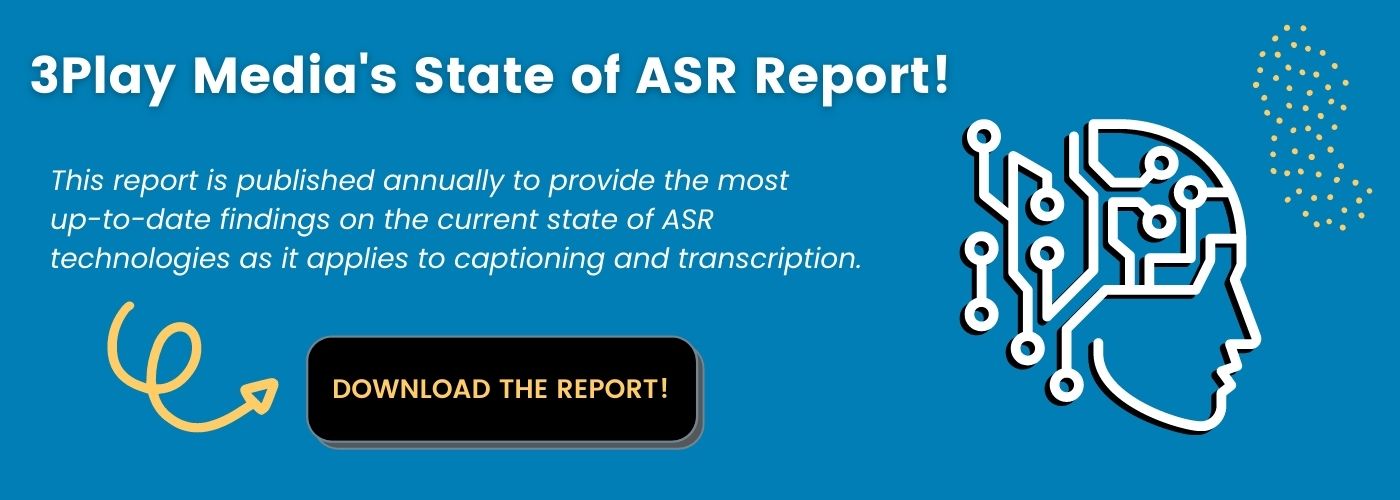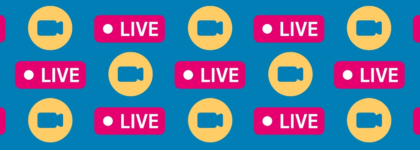Top 5 Use Cases for Live Captioning
Updated: October 21, 2021
Many brands and organizations are turning to live videos to engage with their audience, especially when they can’t connect in person.
For viewers with competing priorities, live video content provides a great deal of flexibility – as long as there’s a device with an internet connection, you can tune in from anywhere in the world.
While the demand for live streams and virtual events increases, organizations are making their videos more accessible with live captions. Live captioning utilizes automatic speech recognition (ASR) technology or a human stenographer to deliver captions in real-time.
Aside from making live videos accessible to deaf and hard of hearing viewers, live captions also help with focus, engagement, information retention, and much more.
Industries from education to fitness are reaping the benefits of live streams and virtual events with live captions. In this post, we’ll discuss the top 5 use cases for live captioning from various industries.
Learn How ASR Technology Impacts Live Captioning Quality ➡️
#1: Online Learning for Universities, Colleges, or K-12 Schools 🍎
For years now, colleges and universities have offered online courses as an alternative to in-person classes. This option accommodates students with different needs, learning styles, schedules, etc.
On the other hand, most elementary, middle, and high schools solely supported in-person classes. However, due to the 2020 COVID-19 pandemic, many K-12 schools were forced to temporarily shift gears, for the first time, to a virtual learning environment to abide by public health restrictions.
So, what can educational institutions do when in-person classes aren’t available? Live classes! Virtual classes are the next best thing because it still allows students to learn and engage with the course material in real-time.
Many schools, colleges, and universities utilize video platforms with live streaming features to stay connected with students. Video platforms, like Zoom, offer tools such as polls, chat windows, remote annotating, Q&A tabs, and more to maintain engagement virtually.
When live classes include captions, they become more accessible to students with hearing loss – although the benefits of live captions don’t stop there. They also keep all students engaged, focused, and aid in information retention.
A study conducted by the University of South Florida, St. Petersburg (USFSP) found that 42% of students use captions to help them focus. Students expressed that captions helped with their comprehension and understanding of the course material.
When captions are turned on, students can maintain focus and retain more information. Some students even found that listening to the instructor and reading the live captions simultaneously improved their spelling and vocabulary. This is especially useful for courses with plenty of technical terms, like science or mathematics.
#2: Government or Municipal Groups 🏛️
Another industry that’s benefiting from live captioning is government and municipal groups. Many of these institutions are live streaming town halls and board meetings for their citizens.
When these events can’t be conducted in person, governments conduct virtual events, and live captions make them more accessible.
The federal government requires governments and municipalities to guarantee equal opportunity for people with disabilities. This means that electronic information, like video and multimedia, needs to be accessible (i.e., live captioned).
Major accessibility laws like the Americans with Disabilities Act (ADA) and The Rehabilitation Act impact government and municipal groups by ensuring that they don’t discriminate against anyone based on disability.
There are about 48 million people in the United States with hearing loss. Without live captions, virtual events become inaccessible.
At these town halls and board meetings, pertinent information is shared, like public service announcements that may impact safety and quality of life. Plus, it allows governments to have a transparent and immediate dialogue with their citizens. When these events are made accessible with live captioning, citizens can equally receive and understand important information.
Download the 2020 State of ASR Report ➡️
#3: Remote Corporate Meetings and Webinars 🖥️
When corporate organizations aren’t able to meet for in-person meetings, remote meetings are a great alternative. Many organizations even have employees in other parts of the country or the world.
Virtual meetings allow remote employees to stay informed on company updates and stay connected to one another. Senior leaders are also able to share updates on business operations, finances, and other company news.
About 30% of working professionals have a disability, many of which are invisible disabilities. When virtual meetings are live captioned, employers are removing barriers for employees who may have a disability.
Additionally, there are corporate organizations that host webinars. They are either used for internal purposes or shared with an external audience interested in learning more about its offerings.
These webinars tend to be more educational – like a live lecture. Like educational courses, live captions help webinars become more engaging for all viewers, even for those with disabilities. They also give audience members flexibility in sound-sensitive environments where headphones or access to sound may not be available.
#4: Non-Profit Conferences 🎙️
Event planners realize that just because an event can’t happen in person, it doesn’t mean that it needs to be canceled. Organizations are turning to host these conferences solely online or in a hybrid environment instead – like 3Play did for our annual accessibility event, ACCESS.
Oftentimes, team members invest a great deal of time, money, and energy into in-person conferences, and all of that hard work shouldn’t go to waste. If meeting physically isn’t an option, virtual conferences can be just as successful!
To make your conference more accessible to attendees, live captions will help tremendously. A study by the University of Iowa found that people retain information better after seeing and hearing it.
At conferences, experts share a wealth of information from their respective fields. Merely hearing information isn’t always enough for attendees; visual information, like live captions, can be extremely beneficial as well.
With so much effort put into the success of these events, organizations also want their attendees to be focused and retain the information they’re learning, which live captions have been proven to aid.
Additionally, attendees worldwide are attending these conferences, many of which don’t speak English as a first language. Live captions help make the information more clear for English learners.
#5: Virtual Fitness Classes 👟
Last but certainly not least, there has been a growing trend of fitness brands offering alternative online classes for their members. This option is great for people who cannot always adjust their schedule to visit a physical gym but still want to remain active.
Members love the flexibility these courses offer, and non-members love it too. They’re able to dip their toes into fresh and exciting fitness content from the comfort of their homes.
To make their virtual classes more accessible to viewers, many fitness brands are using live captions. This has been a great way for all fitness enthusiasts, regardless of ability, to get moving.
Live captions help brands reach a wider audience, especially when people cannot go to physical gyms. They also help in sound-sensitive environments. For example, if someone is taking a class in a noisy home or with a quiet, sleeping child, they don’t have to worry about sound.
Also, many people like to listen to their own music when working out. Live captions give members the flexibility to workout how and when they want.
Keep Live Captioning Quality in Mind
No matter what industry your brand or organization is in, it’s imperative to ensure the quality of your live captions is up to live captioning standards. It’s simply not enough to have captions; they also need to be accurate for them to be truly accessible.
By following best practices for live captioning quality, you’re ensuring your audience has the best live viewing experience possible!
This blog post was originally published by Samantha Sauld on May 11, 2020, and has since been updated for accuracy, clarity, and freshness.
Further Reading

Subscribe to the Blog Digest
Sign up to receive our blog digest and other information on this topic. You can unsubscribe anytime.
By subscribing you agree to our privacy policy.









